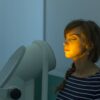I founded MedShadow because I believe that we should all be involved in creating our own health care plans. Too often patients accept recommendations of prescriptions without discussing the risks of side effects balanced against the benefits or alternatives to drugs. From a well-patient check-up to managing end-of-life care the patient should be offered full information about her diagnosis, the treatment options, a drug’s efficacy and side effects.
Research released last week provides statistical support for our mission. It uses a standard scale, PAM (Patient Activation Measure) to show that those who were more engaged in their health care (scored in the upper half of the 4 point scale) had significantly better health outcomes than those who were passive (scored a 1 or 2). While this isn’t surprising, very little research has attempted to quantify this engagement-outcome equation on the health front.
Specifically, the study published in Health Affairs included more than 32,000 people over 2 years. It found “more activated patients were significantly more likely than less activated patients to have HDL, serum triglycerides, and PHQ-9 in the normal range; to be nonsmokers; and not to be obese. More activated patients were also significantly more likely than less activated patients to have obtained cancer screening tests (Pap smears and mammography), and they were significantly more likely to not have a hospitalization or ED visit two years later.” There were flaws in the way the study was structured — for example all the participants were from the same health care group in Minnesota, 60% were female and the mean age was 51. And there were some procedural problems — the timing of the PAM survey vs. the health care measurements. But it’s size and focus makes it important.
Since patient engagement is key to your health, how do you ascertain your level of engagement? Simply put, are you in the top half of the PAM scale headed to better outomes or the lower half with higher risk? PAM is a measure of how willing and prepared a patient is to manage his or her own health. PAM is most often used in the medical system to identify how much support patients will need in managing their own health. It is useful for lay people to know these levels in order to asses what support a family member might need.
The PAM levels of engagement, from least to most involved are:
- Level 1 patients are generally passive about health. This patient may not seek help at the early stages of a worsening condition or seek out screening tests or preventive care. The challenge is to demonstrate to the patient that participation is important.
- Level 2 is about instilling confidence and knowledge in patients who lack the confidence to ask questions, who don’t know when to seek help or how to explore different medical treatment options. They don’t know the nature or causes of their health condition and therefore may not understand a diagnosis or the treatment plan. They cannot be relied on to take action on their own behalf.
- Level 3 involves actually taking action, including maintaining lifestyle changes, knowing how to prevent further problems, and handling symptoms on one’s own.
- Level 4 patients have the ability to “stay the course” even when under stress. They handle problems (rather than simply symptoms) on their own at home, and they can keep their health problems from interfering with their life.
Learning about PAM gave me a vocabulary for the role my sister took on when my father became a widower at age 85. My father had always taken his health for granted (as had I) and, as he aged, ignored the medical realities of aging. I now see he was at level 1, which was very dangerous as his health slowly deteriorated. My sister understood that much more clearly than I. She’s a level 3 or 4. She took action to understand his diagnoses, she got him to the correct doctors, and her efforts kept him healthier and more cogent as he passed the 85-year-old mark.
How does your doctor see you? As a 3? Good for you! What about your teen? A 1? Time to give your child guidance in self-care before he or she leaves home. Sometimes your doctor may seem too busy to answer questions. That’s a good time to check out what info MedShadow has available. We want to support your growth from level 2 to 3 and from 3 to 4. Better health care for all, and it’s all in your own hands.







